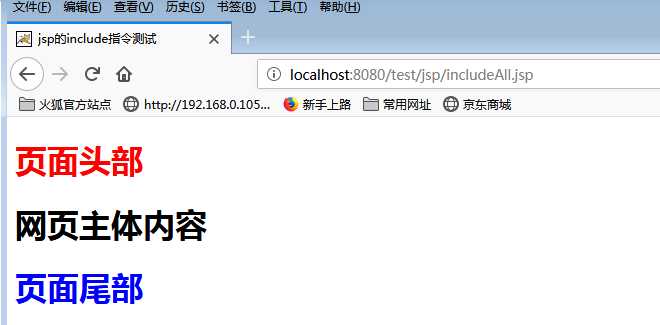标签:形式 blog page 也会 web 结果 try turn safe
一、JSP指令简介
JSP指令(directive)是为了JSP引擎而设计的,它们并不直接产生任何可见输出,而只是告诉引擎如何处理JSP页面中的其余部分。
在JSP 2.0规范中共定义了是三个指令:
JSP指令基本语法格式:<%@ 指令 属性名=“值” %>
例如:
1 <%@ page contentType="text/html; charset=UTF-8""%>
如果一个指令有多个属性,这多个属性可以写在一个指令中,也可以分开写。
例如:
1 <%@ page contentType="text/html; charset=UTF-8" %> 2 <%@ page import="java.util.Date" %>
也可以写作:
1 <%@ page contentType="text/html; charset=UTF-8" import="java.util.Date"%>
二、Page指令
page指令用于定义 JSP页面的各种属性,无论page指令出现在JSP页面中的什么地方,它作用的都是整个JSP页面,为了保持程序的可读性和遵循良好的编程习惯,page指令最好是放在整个JSP页面的起始位置,例如:

JSP 2.0规范中定义的page指令的完整语法;
<%@ page [ language="java" ] [ extends="package.class" ] [ import="{package.class | package.*}, ..." ] [ session="true | false" ] [ buffer="none | 8kb | sizekb" ] [ autoFlush="true | false" ] [ isThreadSafe="true | false" ] [ info="text" ] [ errorPage="relative_url" ] [ isErrorPage="true | false" ] [ contentType="mimeType [ ;charset=characterSet ]" | "text/html ; charset=ISO-8859-1" ] [ pageEncoding="characterSet | ISO-8859-1" ] [ isELIgnored="true | false" ] %>
2.1、page指令的import属性
在jsp页面中,Jsp引擎会自动导入下面的包
可以在一条page指令的import属性中引入多个类或包,其中的每个包或类之间使用逗号(,)分隔
例如:
<%@page import="java.util.*,java.io.*,java.math.*"%>
上面的语句也可以写为使用多条page指令的impoert属性来分别引入各个包或类
例如:
1 <%@page import="java.math.*"%> 2 <%@page import="java.io.*"%> 3 <%@page import="java.util.*"%>
三、include指令
在Jsp中对于包含有两种语句形式:
1.@incude指令
2.<jsp:include>指令
3.1、@include指令
@include可以包含任意的文件,当然只是把文件的内容包含进去。
include指令用于引入其它JSP页面,如果使用include指令引入了其它JSP页面,那么JSP引擎将把这两个JSP翻译成一个Servlet。所以include指令引入通常也称之为静态引入。
语法: <%@ include file="relativeURL" %>,其中的file属性用于指定被引入文件的路径。路径以"/"开头,表示代表当前web应用。
1.被引入的文件必须遵循JSP语法
2.被引入的文件可以使用任意的拓展名,即时其拓展是html,JSP引擎也会按照jsp页面的方式处理它里面的内容,为了见名知意,JSP规范建议使用.jspf(JSP fragments(片段))作为静态引入文件的扩展名。
3.由于使用include指令将会涉及到2个JSP页面,并会把两个JSP翻译成一个servlet,所以这两个JSP页面的指令不能冲突(除了pageEncoding和导包除外)。
include指令使用范例:
新建head.jspf页面和foot.jspf页面,分别作为jsp页面的头部和尾部,存放于WebRoot下的jsp文件夹中,代码如下:
head.jspf代码:
<%@ page language="java" contentType="text/html; charset=UTF-8"%> <h1 style="color: red">页面头部</h1>
foot.jspf代码:
<%@ page language="java" pageEncoding="UTF-8"%> <h1 style="color:blue">页面尾部</h1>
在WebContent文件夹下创建一个includeAll.jsp页面,在IncludeTagTest.jsp页面中使用@include指令引入head.jspf页面和foot.jspf页面,代码如下:
<%@ page language="java" contentType="text/html; charset=UTF-8" pageEncoding="UTF-8"%> <!DOCTYPE html PUBLIC "-//W3C//DTD HTML 4.01 Transitional//EN" "http://www.w3.org/TR/html4/loose.dtd"> <html> <head> <meta http-equiv="Content-Type" content="text/html; charset=UTF-8"> <title>jsp的include指令测试</title> </head> <body> <!-- 使用include标签引入其它JSP页面 --> <%@include file="/jsp/head.jsp" %> <h1>网页主体内容</h1> <%@include file="/jsp/foot.jsp" %> </body> </html>
结果:

我们查看一下jsp引擎将includeAll.jsp翻译成IncludeAll_jsp类之后的源代码,找到Tomcat服务器的work\Catalina\localhost\test\org\apache\jsp目录下找到IncludeTagTest_jsp.java,如下图所示:

打开includeAll_jsp.java,代码如下所示:
package org.apache.jsp.jsp; import javax.servlet.*; import javax.servlet.http.*; import javax.servlet.jsp.*; import java.util.*; public final class includeAll_jsp extends org.apache.jasper.runtime.HttpJspBase implements org.apache.jasper.runtime.JspSourceDependent { private static final javax.servlet.jsp.JspFactory _jspxFactory = javax.servlet.jsp.JspFactory.getDefaultFactory(); private static java.util.Map<java.lang.String,java.lang.Long> _jspx_dependants; static { _jspx_dependants = new java.util.HashMap<java.lang.String,java.lang.Long>(2); _jspx_dependants.put("/jsp/foot.jspf", Long.valueOf(1570108097325L)); _jspx_dependants.put("/jsp/head.jspf", Long.valueOf(1570108081184L)); } private javax.el.ExpressionFactory _el_expressionfactory; private org.apache.tomcat.InstanceManager _jsp_instancemanager; public java.util.Map<java.lang.String,java.lang.Long> getDependants() { return _jspx_dependants; } public void _jspInit() { _el_expressionfactory = _jspxFactory.getJspApplicationContext(getServletConfig().getServletContext()).getExpressionFactory(); _jsp_instancemanager = org.apache.jasper.runtime.InstanceManagerFactory.getInstanceManager(getServletConfig()); } public void _jspDestroy() { } public void _jspService(final javax.servlet.http.HttpServletRequest request, final javax.servlet.http.HttpServletResponse response) throws java.io.IOException, javax.servlet.ServletException { final javax.servlet.jsp.PageContext pageContext; javax.servlet.http.HttpSession session = null; final javax.servlet.ServletContext application; final javax.servlet.ServletConfig config; javax.servlet.jsp.JspWriter out = null; final java.lang.Object page = this; javax.servlet.jsp.JspWriter _jspx_out = null; javax.servlet.jsp.PageContext _jspx_page_context = null; try { response.setContentType("text/html; charset=UTF-8"); pageContext = _jspxFactory.getPageContext(this, request, response, null, true, 8192, true); _jspx_page_context = pageContext; application = pageContext.getServletContext(); config = pageContext.getServletConfig(); session = pageContext.getSession(); out = pageContext.getOut(); _jspx_out = out; out.write("\r\n"); out.write("<!DOCTYPE html PUBLIC \"-//W3C//DTD HTML 4.01 Transitional//EN\" \"http://www.w3.org/TR/html4/loose.dtd\">\r\n"); out.write("<html>\r\n"); out.write("<head>\r\n"); out.write("<meta http-equiv=\"Content-Type\" content=\"text/html; charset=UTF-8\">\r\n"); out.write("<title>jsp的include指令测试</title>\r\n"); out.write("</head>\r\n"); out.write("<body>\r\n"); out.write("\t<!-- 使用include标签引入其它JSP页面 -->\r\n"); out.write("\t"); out.write("\r\n"); out.write("<!DOCTYPE html PUBLIC \"-//W3C//DTD HTML 4.01 Transitional//EN\" \"http://www.w3.org/TR/html4/loose.dtd\">\r\n"); out.write("<html>\r\n"); out.write("<head>\r\n"); out.write("<meta http-equiv=\"Content-Type\" content=\"text/html; charset=UTF-8\">\r\n"); out.write("<title>Insert title here</title>\r\n"); out.write("</head>\r\n"); out.write("<body>\r\n"); out.write("\t<h1 style=\"color: red\">页面头部</h1>\r\n"); out.write("</body>\r\n"); out.write("</html>"); out.write("\r\n"); out.write("\t<h1>网页主体内容</h1>\r\n"); out.write("\t"); out.write("\r\n"); out.write("<body>\r\n"); out.write("\t<h1 style=\"color:blue\">页面尾部</h1>\r\n"); out.write("</body>\r\n"); out.write("</html>"); out.write("\r\n"); out.write("</body>\r\n"); out.write("</html>"); } catch (java.lang.Throwable t) { if (!(t instanceof javax.servlet.jsp.SkipPageException)){ out = _jspx_out; if (out != null && out.getBufferSize() != 0) try { out.clearBuffer(); } catch (java.io.IOException e) {} if (_jspx_page_context != null) _jspx_page_context.handlePageException(t); else throw new ServletException(t); } } finally { _jspxFactory.releasePageContext(_jspx_page_context); } } }
可以看到,head.jspf和foot.jspf页面的内容都使用out.write输出到浏览器显示了。
使用@include可以包含任意的内容,文件的后缀是什么都无所谓。这种把别的文件内容包含到自身页面的@include语句就叫作静态包含,作用只是把别的页面内容包含进来,属于静态包含。
jsp:include指令为动态包含,如果被包含的页面是JSP,则先处理之后再将结果包含,而如果包含的是非*.jsp文件,则只是把文件内容静态包含进来,功能与@include类似。后面再具体介绍
标签:形式 blog page 也会 web 结果 try turn safe
原文地址:https://www.cnblogs.com/sacai/p/11620961.html